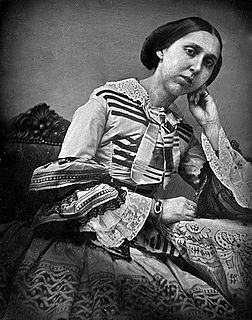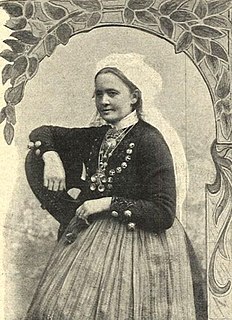Related Research Articles

The Jacquard machine is a device fitted to a loom that simplifies the process of manufacturing textiles with such complex patterns as brocade, damask and matelassé. The resulting ensemble of the loom and Jacquard machine is then called a Jacquard loom. The machine was patented by Joseph Marie Jacquard in 1804, based on earlier inventions by the Frenchmen Basile Bouchon (1725), Jean Baptiste Falcon (1728), and Jacques Vaucanson (1740). The machine was controlled by a "chain of cards"; a number of punched cards laced together into a continuous sequence. Multiple rows of holes were punched on each card, with one complete card corresponding to one row of the design.

A picture stone, image stone or figure stone is an ornate slab of stone, usually limestone, which was raised in Germanic Iron Age or Viking Age Scandinavia, and in the greatest number on Gotland. More than four hundred picture stones are known today. All of the stones were probably erected as memorial stones, but only rarely beside graves. Some of them have been positioned where many people could see them at bridges and on roads.

Damask is a reversible patterned fabric of silk, wool, linen, cotton, or synthetic fibers, with a pattern formed by weaving. Damasks are woven with one warp yarn and one weft yarn, usually with the pattern in warp-faced satin weave and the ground in weft-faced or sateen weave. Twill damasks include a twill-woven ground or pattern.

Morris, Marshall, Faulkner & Co. (1861–1875) was a furnishings and decorative arts manufacturer and retailer founded by the artist and designer William Morris with friends from the Pre-Raphaelites. With its successor Morris & Co. (1875–1940) the firm's medieval-inspired aesthetic and respect for hand-craftsmanship and traditional textile arts had a profound influence on the decoration of churches and houses into the early 20th century.

Princess Eugénie of Sweden and Norway was a member of the royal House of Bernadotte and a philanthropist and amateur artist.
Hayv Kahraman is an Iraqi-American artist of Kurdish descent, who was born in Baghdad and fled to Sweden with family during the Gulf War, studied in Florence, and is currently based in Los Angeles. She primarily paints, but also sculpts and sketches. Her works reflect the controversial issues of gender, specifically concerning female identity in relation to her experiences as a refugee, and all issues that plague her home country. She explores the victimization of women within their own culture, and the effects of their subjugation which causes them the most suffering in the midst of war. She paints on linen panels and depicts dark haired, pale skinned women and decorates her work with Islamic geometric patterns. Her influences range from Persian, Japanese and Italian Renaissance paintings. Her works juxtapose traditional Eastern and Western beauty standards.

Ulla Stenberg, née Colliander (1792–1858) was a Swedish damask maker.

Carpets and rugs have been handmade in Sweden for centuries, taking on many different forms and functions over the course of time. Rugs woven in the traditional Oriental manner, especially in the Ottoman Empire and points east, were originally brought to Sweden over trade routes as early as the early Middle Ages. In the centuries that followed, Swedish rug-makers often infused their works with themes and motifs traditionally found in Oriental rugs. Eventually, Swedish rug-makers would begin to use Oriental rug-making techniques, but themes and motifs more consistent with the artistic and cultural heritage of Sweden. By the early modern periods, rugs had long been an important avenue of art – especially folk art – in Swedish culture. By the beginning of the twentieth century, the craft was seen as being an important artistic and cultural practice throughout Sweden, and designers began to make rugs that had a broad international appeal. Swedish rugs from the mid-twentieth century remain among the most desirable and sought after in the rug world.

Events from the year 1804 in Sweden

William Blair Bruce was a Canadian painter. He studied in France and became one of Canada's first impressionist painters. He lived most of his life in France and on the island of Gotland, Sweden, where he and his Swedish wife Carolina Benedicks-Bruce created the artists estate Brucebo, which was later established as a nature reserve.

Carolina Maria Benedicks-Bruce was a Swedish sculptor. After studies at the Academy of Arts in Sweden she went to France, at first to study and later to live and work at the artists' colony in Grez-sur-Loing where she met her husband William Blair Bruce. With him she returned to Sweden and together they created the artists estate Brucebo on Gotland, which was later established as a nature reserve. She also worked actively with the preservation of heritage buildings, women's right to vote and establishing the Swedish Women's Voluntary Defence Organization.

Helena Hernmarck is a Swedish tapestry artist who lives and works in the United States. She is best known for her monumental tapestries designed for architectural settings.

Dora Elisabet Jung was textile artist, craftswoman, and industrial designer from Finland. Her career lasted five decades. She designed products and works of art made out of linen which can be found in homes, churches, and public buildings. She was known for her expertise in designing woven damask fabrics with abstract motifs.
Lili Blumenau (1912–1976) was an American fiber artist. She was a pivotal figure in the development of fiber arts and textile arts, particularly weaving, in the United States during the mid-part of the 20th century.

Ernestine Nyrop (1888–1975) was a Danish textile artist and fresco painter who is remembered for decorating churches in Denmark and Sweden. In 1930, she published a series of traditional Danish sewing and weaving patterns in Danske Mønstre til Syning og Vævning I-II. From 1937 to 1959, Nyrop contributed actively to Dansk Paramenthandel, an organization devoted to ensuring high-quality standards for textile art in churches.

Johanna Brunsson (1846–1920) was a Swedish weaving arts instructor and school founder.

Cilluf Olsson was a Swedish textile artist. She was an important figure within Svensk Hemslöjd.
Grethe Søorensen is a Danish textile artist. A pioneer in the field of digital weaving in which she combines traditional craftsmanship with technological innovation, in 2017 she received the Nordic Award in Textiles. Her works are held in the permanent collections of major design museums, including the Cooper Hewitt, Smithsonian Design Museum in New York and Designmuseum Danmark in Copenhagen.

Emma Carolina Helena ("Lilli") Zickerman (1858–1949) was a Swedish textile artist who pioneered the Swedish Handicraft Association in 1899. In 1914, she embarked on the creation of an inventory of popular textile art in Sweden, documenting some 24,000 items with photographs and samples of threads by 1932.

Elna Mygdal (1868–1940) was a Danish textile artist, museum curator and writer. She is remembered in particular for her interest in Hedebo embroidery and for her collection of folk costumes and folk textiles. In 1930, she published the authoritative two-volume Amagerdragter: vævninger og syninger on the history of costumes and textiles from Amager, an island adjacent to Copenhagen.
References
- Du Rietz, Anita, Kvinnors entreprenörskap: under 400 år, 1. uppl., Dialogos, Stockholm, 2013